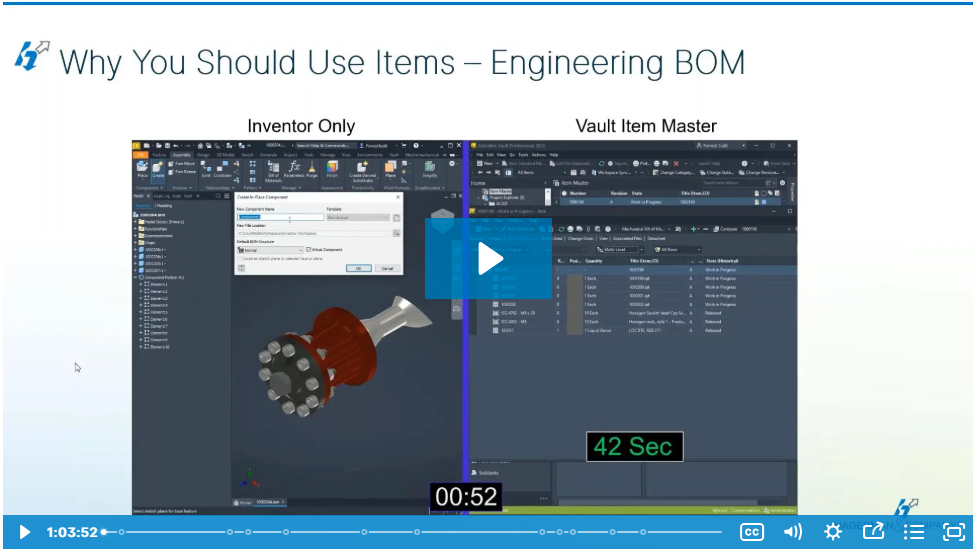Imagine, for a moment, you’re overseeing a large-scale project. You have multifaceted challenges like intricate documentation, diverse teams, strict compliance standards, and client demands.
Wouldn’t it be helpful if all of those documentation processes could be automated to save you time?
That’s why automation is a big part of the future of manufacturing plants. Automating asset lifecycle information management (ALIM) with tools from Autodesk® can help streamline every project phase, from organizing to synchronizing maintenance schedules.
Better engineering document management enhances efficiency and accuracy while allowing plant leaders to think more widely about the projects. It creates space to think more critically and avoid getting too caught up in the details. That, primarily, is why modern, automated document management solutions will play a vital role in the future of plant engineering.
We’re not alone in this belief, either. Forbes argues that automation is a catalyst for the future of human innovation.
“Automation is opening doors to new opportunities. This year, more businesses will see how beneficial hyperautomation can be, as it allows humans to utilize their greatest asset: their brains. Hyperautomation in businesses of all sizes can free up employees to do creative thinking and leave the monotonous work to automated technology.”
- Manoj Chaudhary, via Forbes
The Current Challenges in Automating Asset Lifecycle Information Management in Plants
But before we can dive into how to use documentation automation in your organization, it’s important to outline the current hurdles in engineering processes. The below challenges each represent a critical area where engineering document or asset lifecycle information management can significantly impact the success of plant projects.
- Document Management Complexity: Engineering projects are a web of timelines, milestones, and deliverables. Managing this complexity requires a system that can track and coordinate every documented detail.
- Resource Allocation Difficulties: Appropriately utilizing resources on both small and large-scale projects is a balancing act. ALIM ensures optimal use of materials, personnel, and time.
- Team Management Obstacles: Members of engineering teams have different responsibilities and effective leadership. ALIM acts as a centralized hub of plant information and helps bridge gaps.
- Client Expectations and Pressure: Stakeholders in engineering projects demand results and excellence. ALIM allows for enabling tracking and managing of project stages for better communication.
- Regulatory Compliance: Industry standards are continuously evolving, but ALIM keeps things simple and compliant – and helps avoid any potential surprises.
- Technology Integration Necessities: By keeping a central hub of project documentation in a platform like Autodesk Vault, a legacy data migration to any new or upgraded software is simplified. Teams can tap into the potential of new tools without risk to the project.
- Risk Management Value: For effective asset lifecycle information management, plant directors must have a birds-eye view of the project’s lifecycle. That means there’s an opportunity for proactive risk management – keeping ahead of any potential problems that might arise.
These document management challenges exist for both large and small-scale plant engineering projects. ALIM helps mitigate each one, but it does not eliminate them. Each must be recognized and addressed in order to see a project through to completion.
The Role of Automated Solutions in Addressing These Challenges
Let’s talk about the potential of automating document and asset lifecycle information management, allowing plant leaders and engineers to think more broadly about their projects. It’s no surprise that getting caught in the web of muddled details often can delay project timelines and lead to higher costs.
By using modern technology, your team can overcome these challenges in plant manufacturing. It has the potential to accelerate engineering processes and more.
From initial kickoff to completion, each step is tracked and coordinated. Resource allocation is optimized, meaning a more effective use of materials required by engineers and team personnel. Compliance is easier and project expectations are more easily managed.
The overall benefit of automated document management is three-fold:
- Silos across plant engineers and other teams are broken down.
- Leaders and project managers can make decisions more quickly.
- The overall process of projects is more unified.
Future Trends in Plant Engineering and Process Automation
These process innovations are not only helping the present but also improving the future. There are several key documentation automation trends that are set to optimize plant engineering processes.
The increasing use of automation will help with the skilled manufacturing talent shortage. What that means is tools built with AI will continue to automate routine tasks. That shift will boost productivity and reduce the amount of workers needed. A recent Harvard Business Review survey found that 92% of workers believe automation has improved their lives in the workplace and helped them be less stressed.
What that primarily means is more time for creative thinking – not just with plant leaders, but with engineers on the ground, as well. Automation will encourage engineers on all types of projects to go the extra mile with their new time. It’s difficult to predict exactly where that will take our world, but the potential is tremendous, and potentially revolutionizing.
So how can you start implementing document automation into your current lifecycle information management process? Start by embracing modern processes and technology.
Curious to discover more? Learn more about the Hagerman approach to asset or document management consulting services!
Our team offers expert training and EDM implementation services. We start with a thorough analysis, and then we create a plan to execute it. For the past 40 years, we have provided these services to thousands of companies throughout the US.




Comments